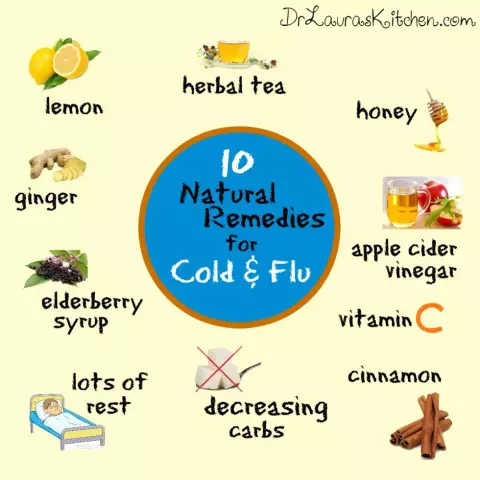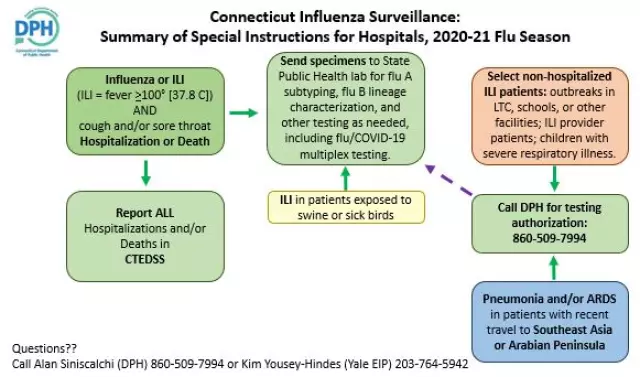- Author Rachel Wainwright [email protected].
- Public 2023-12-15 07:39.
- Last modified 2025-11-02 20:14.
Bird flu
The content of the article:
- Causes and risk factors
- Disease stages
- Bird flu symptoms
- Features of the course of the disease in children
- Diagnostics
- Treatment
- Possible complications and consequences
- Forecast
- Prevention
Avian influenza is an acute infectious and viral disease in which there is a predominant lesion of the gastrointestinal system, the respiratory tract, as well as high mortality. Due to the presence of highly virulent strains of the virus, as well as antigenic variability, avian influenza is classified as a particularly dangerous disease that can cause large economic losses.
The disease was first described in 1878 by the Italian veterinarian Eduardo Perronchito. The viral nature of the infection was established in 1901. Avian influenza in humans was first reported in 1997 in Hong Kong, where the first outbreak of the disease occurred. Further, bird flu spread to the countries of Europe and Africa, affecting birds and people.

Source: gripptips.ru
Causes and risk factors
The causative agent of the infection is the influenza A virus, which belongs to enveloped viruses. The virion is covered with a lipid membrane with glycoprotein spicules, has an oval or irregular shape. Spicules are the main antigens of the virus and determine its hemagglutinating and neuraminidase activity. The combination of hemagglutinin variants (15 known) and neuraminidase (9 known) determines the presence of subtypes of the virus that have different virulence. The genome of the virus is represented by single-stranded RNA, which consists of eight separate segments.
The main subtypes of the virus that can cause the development of the disease in humans are H5, H7 and H9. Strains H5N1 and H7N7 pose a great danger to humans, as they are prone to rapid mutation and can cause severe forms of avian influenza with a fulminant course and a high risk of death. At the same time, the H5N1 strain demonstrated the highest pathogenicity, the ability to directly infect humans, cause multi-organ disorders, and resistance to traditional antiviral drugs.
Migratory wild birds (ducks, geese, swans, terns, herons) and domestic birds (chickens, turkeys) serve as the reservoir of infection. The virus is located in the intestines of birds, is excreted into the external environment with feces, saliva, and respiratory material. Can be stored on agricultural equipment. Seasonal migration of wild birds leads to the spread of the infectious agent over long distances.

Source: sekretizdorovya.ru
The bird flu virus is resistant to low temperatures, dies after boiling in 2-3 minutes. In poultry droppings, it remains for about three months, in water at room temperature - up to four days, inactivated using conventional disinfectants.
Human infection occurs through airborne droplets, fecal-oral routes, as well as through contact with a bird infected or dead from this disease. At risk of contracting avian influenza are veterinarians, livestock specialists, workers in poultry farms and farms.
Risk factors include:
- immunodeficiency states;
- eating poultry and eggs that have not undergone sufficient heat treatment;
- non-compliance with the rules of personal hygiene;
- age (children under five and the elderly are the most vulnerable);
- living in regions with an unfavorable epidemiological situation or visiting them.
The mechanism of development of avian influenza in humans is not well understood. It is known that the site of viral replication is the epithelial cells of the respiratory tract and intestines (enterocytes).
The risk of developing severe forms of the disease increases with late diagnosis, significant damage to the respiratory system, the development of multiple organ dysfunction, severe leukopenia.
Disease stages
In the clinical picture of avian influenza, the incubation period, the period of pronounced clinical manifestations and convalescence, i.e., recovery, are distinguished.
Bird flu symptoms
The incubation period for bird flu is from 2-3 days to 2 weeks (less often). At this time, the disease does not manifest itself in anything, however, the virus, having entered the body, is actively replicating.
The disease manifests itself as respiratory (catarrhal), gastrointestinal and infectious-toxic syndromes.
The onset is usually acute. The body temperature rises to 38-40 ° C, which is accompanied by chills, headaches, joint and muscle pains. In some cases, mucous nasal discharge, rhinorrhea (nosebleeds), conjunctivitis, bleeding gums appear.
If gastrointestinal syndrome develops, abdominal pain, repeated vomiting and diarrhea occur. The feces are usually watery.
Catarrhal syndrome is manifested by the development of laryngitis, bronchitis, bronchiolitis. Pharyngitis often occurs, characterized by intense sore throat and a burning throat. In 2-3 days after the first clinical signs of avian influenza appear, the patient may develop interstitial viral pneumonia.
She has the following clinical symptoms: cough, hemoptysis, clear sputum, shortness of breath, cyanosis, rapid shallow breathing. During auscultation over the lungs, moist rales of various sizes, hard breathing, crepitus are heard. The inflammatory process in the lungs progresses rapidly, which causes the development of acute respiratory distress syndrome. At this stage, a secondary bacterial or mycotic infection sometimes joins. Death in avian influenza occurs in the second week after the onset of the disease from acute respiratory failure, pulmonary edema, multiple organ failure.
Acute renal failure occurs in about 35% of cases of avian influenza. An increase in the size of the liver is possible.

Source: podolskriamo.ru
Features of the course of the disease in children
The most severe course of bird flu is characteristic of young children. In patients of this age group, the disease is often accompanied by vomiting, headache, and disturbances of consciousness; sometimes meningoencephalitis develops. The febrile period lasts 10-12 days, with a particularly severe course of the disease continues until the death of the patient.
Diagnostics
The diagnosis of avian influenza is based on data obtained from the collection of complaints and anamnesis, physical examination, instrumental and laboratory studies. When collecting anamnesis, attention is focused on probable contact with domestic or wild birds, eating poultry and / or eggs that have not undergone sufficient heat treatment, probable contact with infected persons, involvement in laboratory research or farming activities.
A preliminary diagnosis can be made in case of detection of clinical manifestations of the disease during an epidemic outbreak of avian influenza, reports of the death of poultry in the region where the patient lives, through contact with a patient who has a confirmed diagnosis of avian influenza, staying in regions with an epidemiological environment, the patient has a professional risk of developing the disease.
To confirm the diagnosis of avian influenza, enzyme immunoassay, polymerase chain reaction and other virological studies are used.
With an increase in the size of the liver in the biochemical blood test, an increase in the concentration of hepatic transaminases is noted. In a third of patients, an increase in the level of creatinine in the blood is found. In the general analysis of blood, an increase in the number of leukocytes, lymphopenia, and a decrease in the number of platelets are noted.
With the help of radiography, already in the early period of the disease, multiple inflammatory infiltrates are found, which are prone to fusion and rapid spread through the lung tissue. Sometimes lobar or segmental seals are visible on radiographs.
Differential diagnostics is carried out with the usual seasonal influenza, parainfluenza, adenovirus, rhinovirus, enterovirus, respiratory syncytial infection, legionellosis.
Treatment
Patients with suspected avian influenza or an established diagnosis must be admitted to an infectious diseases hospital. In the acute period of the disease, bed rest is indicated. Etiotropic therapy is carried out with antiviral drugs that block viral replication.
When the body temperature rises to febrile values (above 38 ° C), antipyretic drugs are prescribed. When a secondary bacterial or mycotic infection is attached, antibacterial or antifungal agents are used, respectively. According to clinical indications (in order to correct the electrolyte balance and acid-base balance), intravenous administration of crystalloid solutions is carried out. In severe cases of the disease, it may be necessary to prescribe glucocorticoids, protease inhibitors.
Patients are shown a sparing diet, full of macro- and micronutrients, and an abundant drinking regimen. Patients are discharged from the hospital no earlier than a week after the normalization of body temperature.
Contact persons are shown dispensary observation for seven days, including measuring body temperature twice a day. If the temperature rises, seek medical attention immediately.
Possible complications and consequences
Against the background of bird flu, severe complications from the respiratory tract, liver damage, kidney damage, leading to hepatic or renal failure, hematopoietic organs, and secondary infections can develop.
Forecast
In most cases, the prognosis is favorable. After the transferred bird flu, a type-specific short-term immunity is formed in humans. When infected with the most pathogenic strains of the virus, the prognosis worsens, the lethality can reach, according to various estimates, up to 50-80%.
Prevention
In order to prevent avian influenza in humans, it is recommended:
- strengthening the body's defenses;
- taking antiviral drugs for preventive schemes;
- compliance with the rules of epidemiological safety when working with poultry and wild birds;
- destruction of infected poultry;
- compliance with the rules of personal hygiene;
- sufficient heat treatment of poultry and eggs before eating.
In order to reduce the risk of infection, and in case of infection - the development of severe complications, persons at risk are recommended vaccination. These are children 2-5 years old, persons who, by virtue of their profession, are in contact with large groups of the population (medical workers, teachers, managers, employees of large enterprises, etc.). Mass vaccination is indicated when the epidemic situation in the region worsens.
Vaccination is not carried out in the presence of a high temperature (regardless of the reason), earlier than two weeks after an acute respiratory illness, with an exacerbation of chronic diseases, in case of individual intolerance to the components of the vaccine (including if there is an allergy to the protein of chicken eggs), autoimmune diseases.

Source: podolskriamo.ru
YouTube video related to the article:

Anna Aksenova Medical journalist About the author
Education: 2004-2007 "First Kiev Medical College" specialty "Laboratory Diagnostics".
The information is generalized and provided for informational purposes only. At the first sign of illness, see your doctor. Self-medication is hazardous to health!






